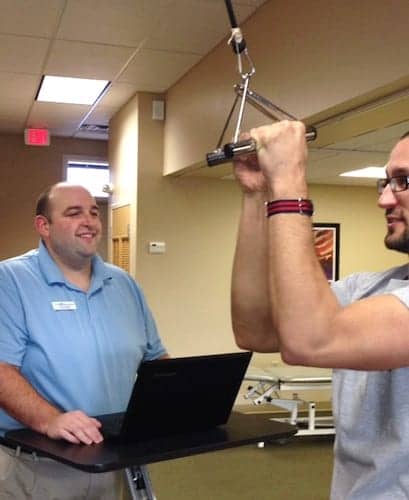A practice with clinics in three states turns to integrated software to improve practice management from end to end.
By Michael Severo, PT, and Gino Compagnone, DPT
Say the words, “physical therapy,” and what springs to mind is hands-on treatment and/or exercise prescription for injuries and conditions ranging from mild to severe. While that may be the essence of physical therapy, the “business” of operating a clinic—from maintaining client records to billing insurers, from interoffice communication to ensuring patients receive the most efficient service—can be prodigious. As such, the need for fully integrated practice-management software has become a particular necessity for ProEx Physical Therapy, a Portsmouth, NH-based practice comprised of multiple clinics spanning three states.
The reasons that dictate the use of an integrated software system are many. Integrated software links clinical and patient data to billing information and vice versa, and also allows for efficient analysis and reporting on both clinical and financial data. Moreover, it eliminates the technical difficulties that often occur among multiple software vendors and streamlines the numerous service agreements warranted when dealing with various vendors.
Other salient justifications for integrated practice-management software in the physical therapy setting include:
• Easier collection and reporting of clinical outcome data;
• The ability for the facility to provide more timely and legible documentation to third-party payors and referral sources;
• The availability of valuable patient balance information to front-line staff;
• More efficient use of clinical personnel with the elimination of paperwork redundancy, and increased and timelier access to accurate, legible records;
• The ability to customize home exercise programs utilizing a video database;
• Mitigation of compliance risk;
• More efficient use of administrative personnel;
• More accurate reporting of net revenue and net accounts receivable; and
• Anticipation of electronic medical records requirements of the Affordable Care Act.
Recognizing the potential of an integrated software system is one thing, but conducting the “due diligence” evaluation and then choosing the appropriate software package is where the real work comes into play.
Selecting an Integrated Software System
In the initial phases of the selection process, the practice’s director of finance was assigned to research and evaluate many of the products and vendors that specialize in medical billing in general and physical therapy billing in particular. He began by listing the pros and cons of each product and then shared his observations with the chief operating officer. They then pared down the list to the three or four products that met the practice’s requirements. An evaluation team consisting of the accounts receivable manager, accountant, director of finance, and chief operating officer was then formed, followed by online demonstrations of each product.
Meetings were conducted by the evaluation team to address pros and cons of each software product, with emphasis on the following:
• The software’s facility to customize clinical templates;
• The level of complication when entering clinical outcome data;
• The front desk’s easy access to key patient balance information;
• Reporting features that allow each of our clinics to pull data and report on our key metrics;
• The technology’s adaptability to future trends in electronic medical records;
• The software’s capability to facilitate clinical and billing compliance and to meet HIPAA compliance regulations; and
• The software’s ability to perform a hard accounting close.
At this point, we contacted several of the selected vendors’ current customers for an open and honest discussion of the likes and dislikes of the various products. We also sought input from our network of IT and compliance consultants. Follow-up demonstrations and question/answer webinars were held with each of the final three vendors. Ultimately, final recommendations were made to our chief executive officer. After an extensive demo session with ProEx Physical Therapy’s CEO and the prospective vendor’s CEO, a unanimous selection decision was made.
New System Training
Once selected, the vendor provided the initial training process for the staff—a combination of video training, specific implementations, and weekly meetings with the vendor’s project manager to address questions. We requested and were granted permission to deviate from the selected vendor’s standard training protocol in a successful attempt to assure a seamless transition and to be in control of training for the practice’s employees.
Initially, a selected group of staff—billing, reporting, finance, clinical staff and senior executives—were trained. In addition to weekly training sessions with the vendor, the practice is creating manuals that will provide training for the remainder of our staff. The entire ProEx Physical Therapy staff underwent a 4-week training period that combined the vendors’ training protocol and in-house enhancements.
The standard training requires roughly 2 hours per week for all staff members throughout the 4-week period. We chose to allot this time during normal work hours to assure successful training, and also assigned “super users” from the evaluation committee for each of the three geographic regions of this multi-clinic company. Templates that were needed both clinically and administratively were created so the practice’s forms would be available electronically during “go live” by all who required them. The practice headquarters was in consistent communication with the separate clinic managers about the process, setting expectations for some while managing expectations for others.
Impact of Integrated Software System to Operations and Patient Care
Having recently completed the software “go live,” we anticipate the most significant positive impact initially will be on financial and operating reporting, timely communication and completion of recertification/authorization paperwork, billing, and the receipt of electronic payments. A moderately prolonged learning curve among clinicians was observed as they transitioned from paper to electronic records. The transition period for all to feel comfortable with the new documentation process lasted approximately 6 months.
The flow of paperwork clearly has changed. Now, rather than create a chart with the appropriate forms (up to eight pieces of paper initially) and place the chart in an “arrived” bin that the physical therapist must monitor, the patient “arrives” with the click of a button and the physical therapist is advised electronically. Forms also are printed with a click and scanned into a patient’s medical record.
The integrated practice-management software system selected greatly affects communication internally as it allows for tasks to be created electronically and checked off as they are completed—which is much more efficient than sticky notes and loose paper.
We recognize the new system places more pressure on the practice’s physical therapists to complete their documentation in a timely manner. The software does not allow a bill to be submitted until all documentation is complete, and because of this, some therapists have changed their approach. Now, these therapists complete the electronic chart while the patient is present rather than waiting until the end of the day.
Multiple staff members have access to records at any given time. As such, exercise technicians can view an exercise flow sheet while the clinician is concurrently documenting the record from a different workstation.
Also worth mentioning is the financial investment that was made to accommodate the new system. In addition to the software itself, there were upgrades to the wireless system in each of the company’s 10 offices as well as the corporate office. Several modifications to the server network were required, as well as the procurement of 40 laptop computers and 20 rolling, adjustable height tables. Added together, the first-year cost of implementing the new software totaled approximately $70,000.
The impact the new system has on patients is also noteworthy, with the most obvious being the visibility of laptops on the clinical floor and the therapist’s periodic use of them to document care. Part of staff training focused on how to accomplish this while continuing to provide a great patient experience. Patients also noticed a change in billing concerns. The new software allows the practice to respond quickly to billing questions, and also prints out a statement for the patient for future appointments. Furthermore, patients find their bill is easier to understand, which helps reduce the number of calls patients make to the office to ask for clarification.
An additional benefit the new software provides to patients is that notes to their physicians that originate from our offices are more legible and timely. With the click of a button and a few keystrokes, you can deliver a professional and customized note to providers in real time.
Technology and Practice Management
Since going live with this integrated practice-management software system, the staff has recognized a complete paradigm shift from paper charts and handwritten notes to a near paperless system. As a result, there have been shared benefits among clinical staff, office staff, and, of course, patients. Looking back at the time spent planning this transition, the practice happily anticipates the cost and time efficiencies that go hand in hand with electronic documentation of patient visits, exercises, outcomes progress notes, billing, and reporting.





